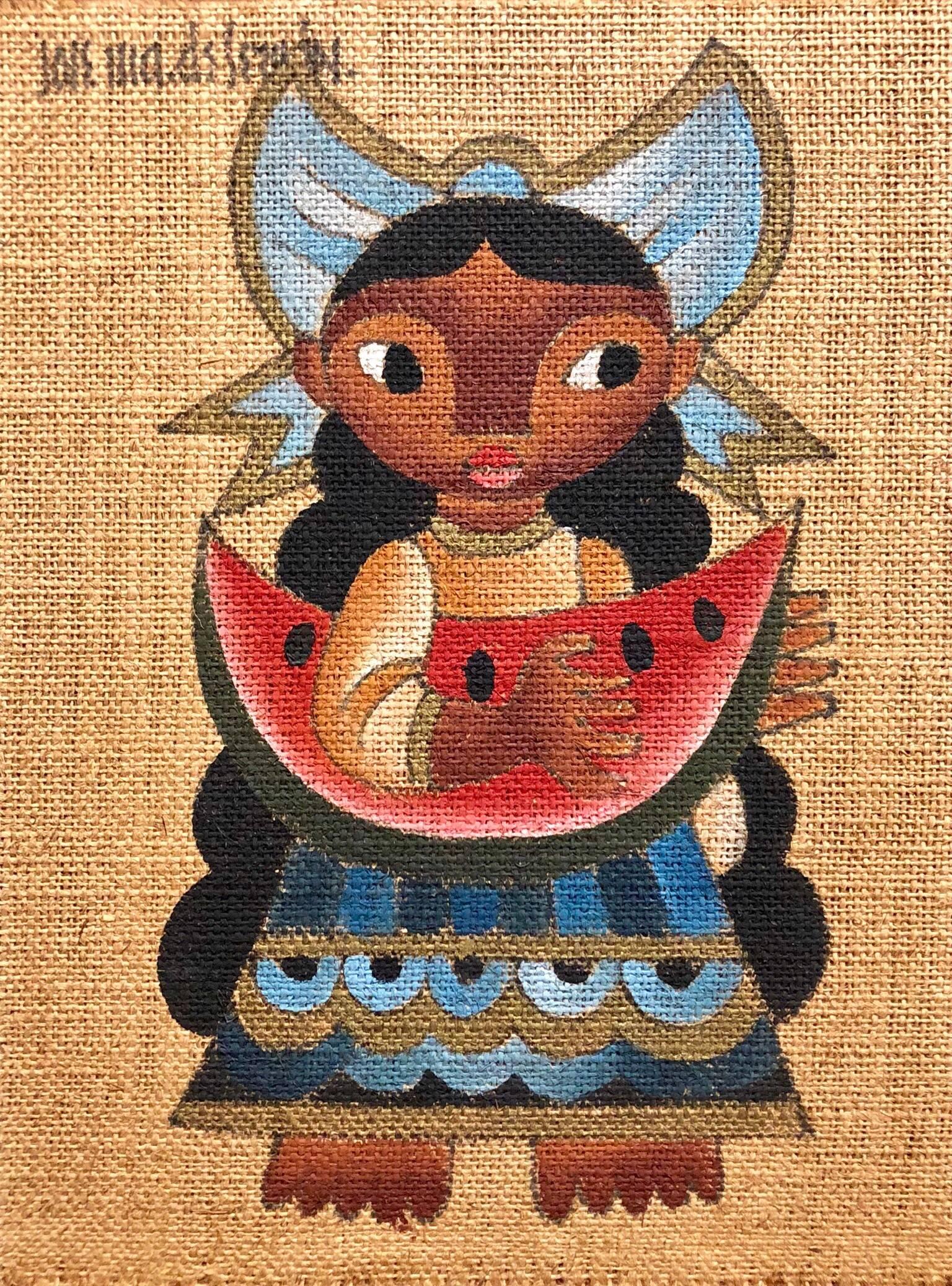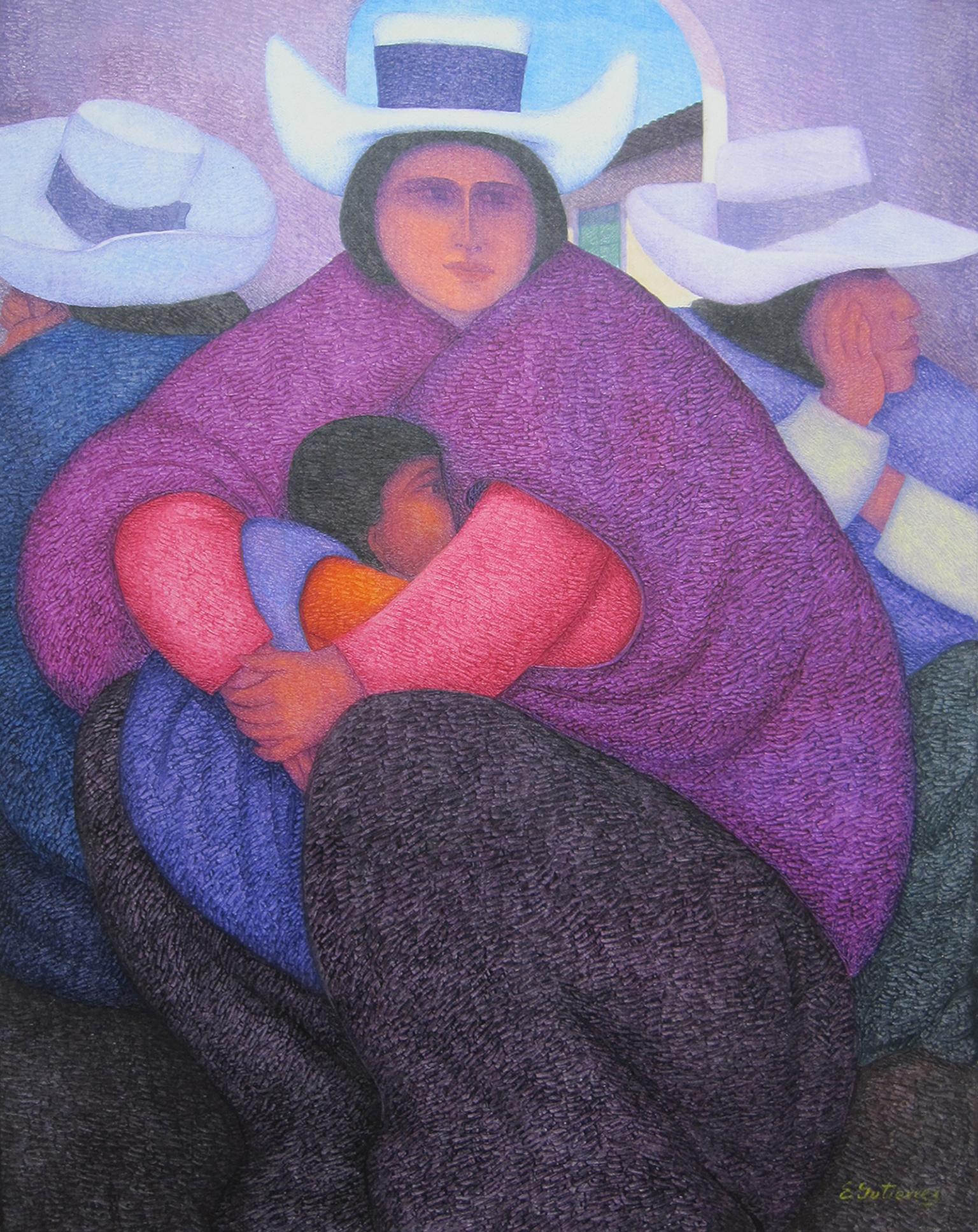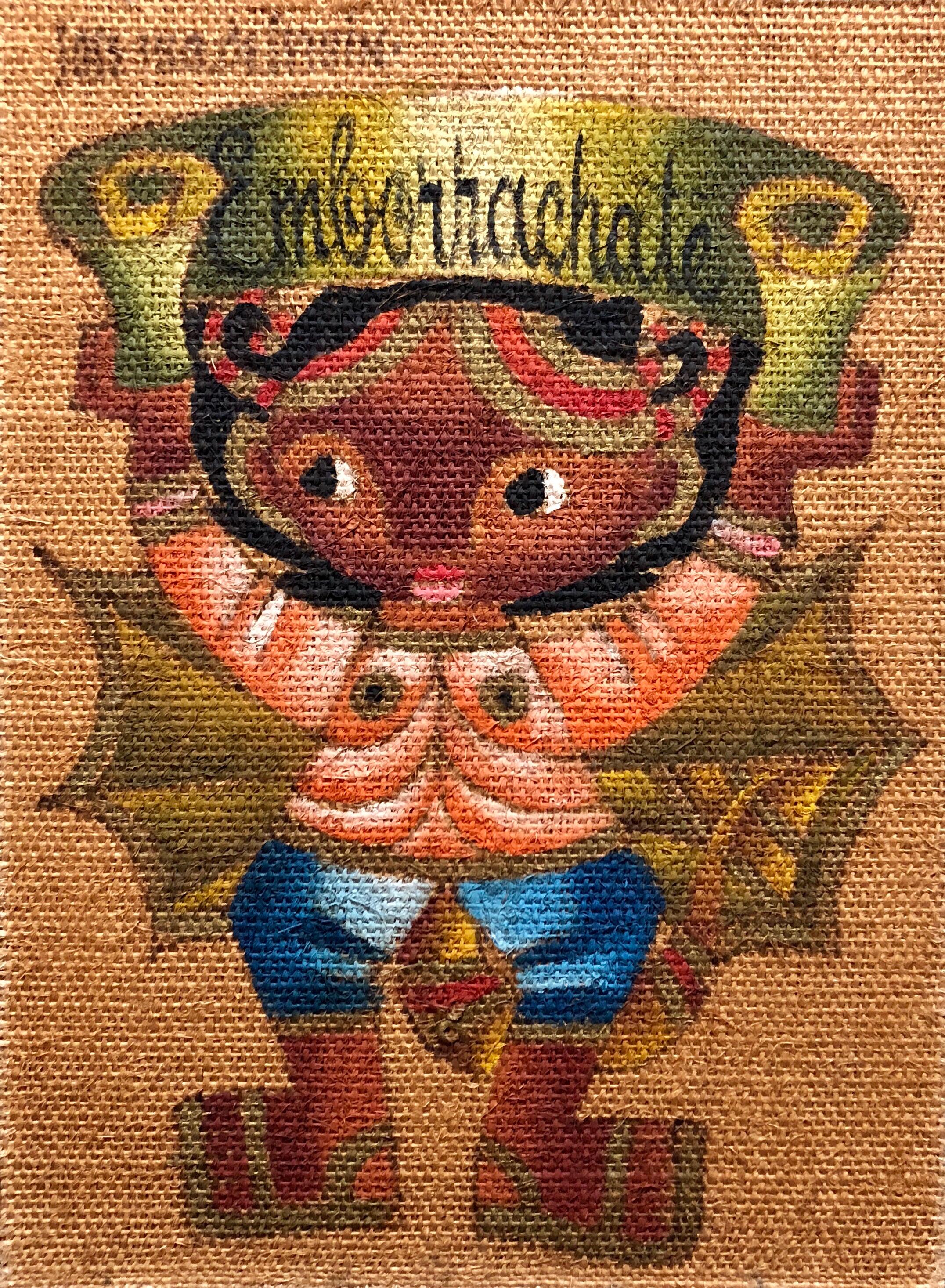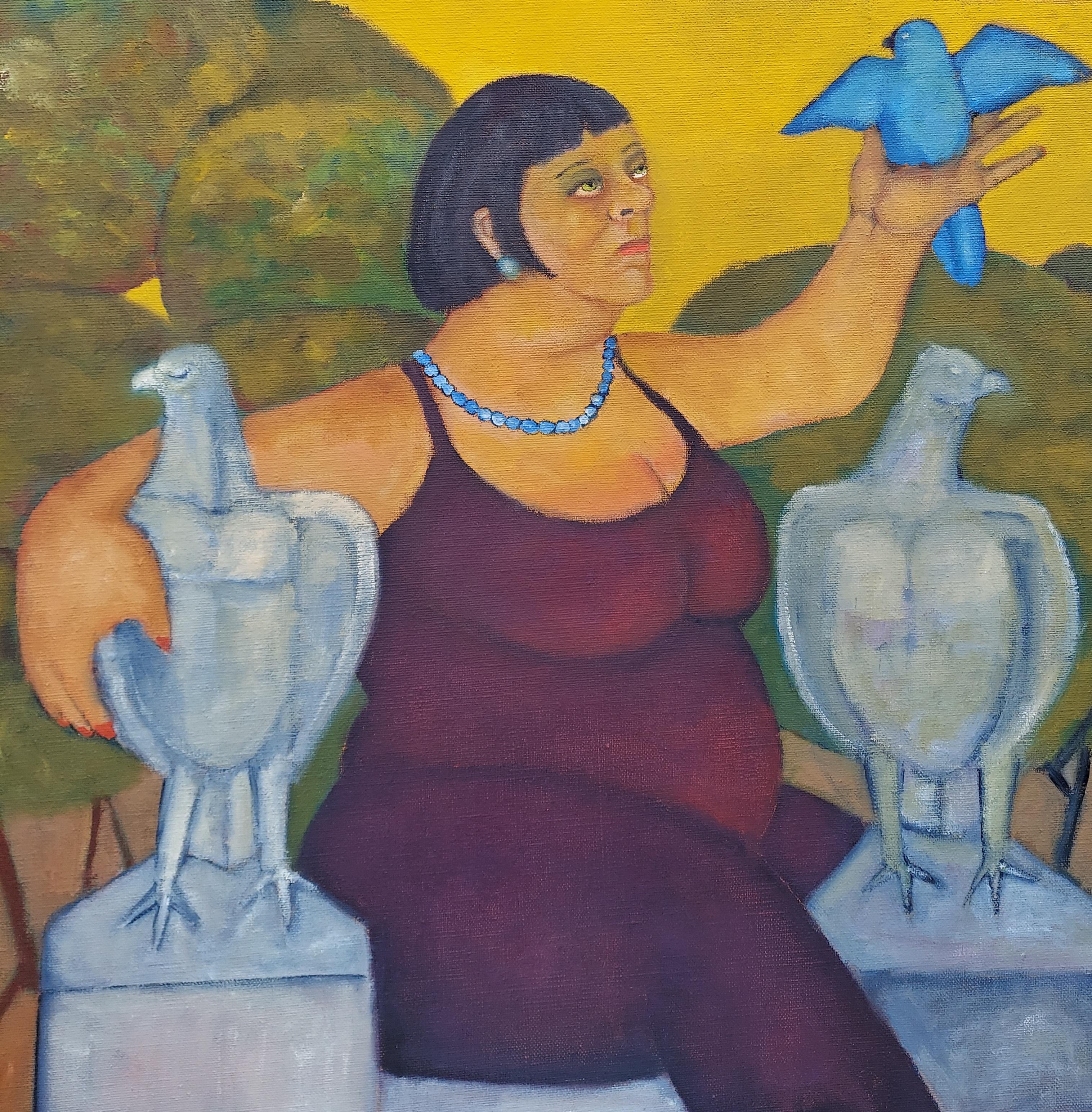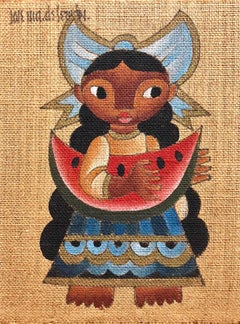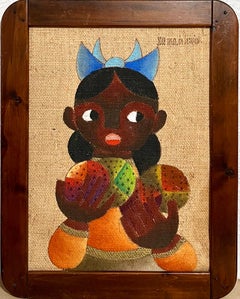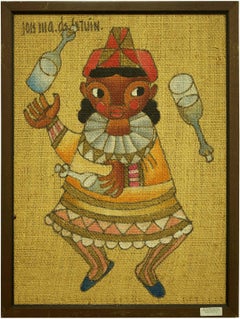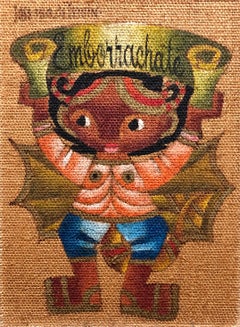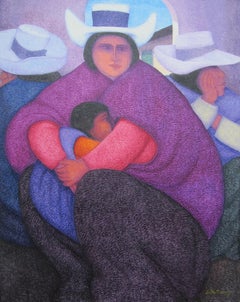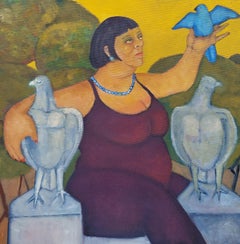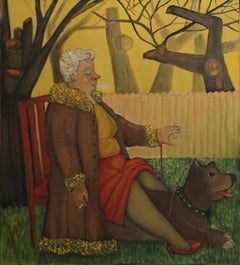Items Similar to Folk Art Mexican Boy Oil Painting on Burlap Charming Naive African American Art
Want more images or videos?
Request additional images or videos from the seller
1 of 11
Jose Maria de ServinFolk Art Mexican Boy Oil Painting on Burlap Charming Naive African American Art
About the Item
Framed 29 X 23
Image 18 X 24
The sweetness that characterizes the work of Mexican painter Jose Maria de Servin (1917-83) is a melancholy and placid one. While he worked in the most modern of styles, he adapted it to an anecdotal folk-art approach distinctly his own.
When he was an infant, de Servin's family moved with him to Guadalajara. A city of history and culture, Guadalajara had a thriving artistic community with strong connections to Europe. His brothers Antonio and Miguel became artists as well, and in later years they worked collaboratively. As a teenager, de Servin studied at one of Mexico's Schools of Open-Air Painting, free art-teaching institutions sponsored by the government.
Later de Servin became a pupil of the painter Chucho Reyes, known for his improvisational watercolor variations on traditional Mexican themes. This interest in imagery particular to Mexico would be of great significance to de Servin. De Servin also studied under the more traditional painter Jose Vizcarra. In the early 1930s de Servin joined the Pintores Jovenes de Jalisco, or Young Painters of Jalisco.
An influence of critical importance to de Servin was Pablo Picasso. One of the originators of Cubism, the Spanish painter soon departed from its quasi-scientific and optical basis to create lively and humorous geometrical abstractions. It was this Cubism, personal and decorative, that de Servin adopted. His earliest Cubist works mimic Picasso, while during the second stage of his career, his works become smooth and polished, with an emphasis on gentle surface textures.
After these cautious years, however, a rough boldness enters along with dominating colors of earth and sand. Modernists like de Servin were interested in exploring what they considered primitive artmaking styles. The adoption of a native manner and native themes is in keeping with Modernist tenets, as is the use of nontraditional materials. De Servin's portraits of peasants, large-eyed and simply rendered, recall children's drawings. The rough burlap ground contrasts with the playful imagery and delicate range of color. The figures, all children or child-like adults, are all curves and simple shapes arranged harmoniously. De Servin's cubism is free from grotesquerie as it celebrates the simplicity of its subjects.
De Servin worked with the social-realist Jose Orozco on several large mural commissions in Guadalajara, including one at the Legislative Palace. While their styles were dissimilar, both made use of Mexican imagery to glorify the common people. A sought-after muralist in his own right, de Servin brought the rich colors and endearing characters of his panels to his larger-scale work.
For 15 years, de Servin taught summer art classes at the University of Arizona. His career was marked by many one-man shows, both in North America and Europe. In recent years, his striking style has attracted increased notice from critics and the public.
His style is a unique conglomerate of tradition, history, legends, heroes, old customs and folklore. It is a self-standing style, recognizable, cheerful, whimsical and a happy creation. Naïve art is any form of visual art that is created by a person who lacks the formal education and training that a professional artist undergoes (in anatomy, art history, technique, perspective, ways of seeing). Unlike folk art, naïve art does not necessarily evince a distinct cultural context or tradition. Naïve art is recognized, and often imitated, for its childlike simplicity and frankness. Paintings of this kind typically have a flat rendering style with a rudimentary expression of perspective.
One particularly influential painter of "naïve art" was Henri Rousseau (1844–1910), a French Post-Impressionist who was discovered by Pablo Picasso. Naïve art is often seen as outsider art that is by someone without formal (or little) training or degree. While this was true before the twentieth century, there are now academies for naïve art. Naïve art is now a fully recognized art genre, represented in art galleries worldwide.
Museums devoted to naïve art now exist in Kecskemét, Hungary; Riga, Latvia; Jaen, Spain; Rio de Janeiro, Brasil; Vicq France and Paris. "Primitive art" is another term often applied to art by those without formal training, but is historically more often applied to work from certain cultures that have been judged socially or technologically "primitive" by Western academia, such as Native American, sub saharan African or Pacific Island art (see Tribal art). This is distinguished from the self-conscious, "primitive" inspired movement primitivism. Another term related to (but not completely synonymous with) naïve art is folk art. There also exist the terms "naïvism" and "primitivism" which are usually applied to professional painters working in the style of naïve art (like Paul Gauguin, Mikhail Larionov, Paul Klee).
At all events, naive art can be regarded as having occupied an "official" position in the annals of twentieth-century art since - at the very latest - the publication of the Der Blaue Reiter, an almanac in 1912. Wassily Kandinsky and Franz Marc, who brought out the almanac, presented 6 reproductions of paintings by le Douanier' Rousseau (Henri Rousseau), comparing them with other pictorial examples. However, most experts agree that the year that naive art was "discovered" was 1885, when the painter Paul Signac became aware of the talents of Henri Rousseau and set about organizing exhibitions of his work in a number of prestigious galleries. The Earth Group (Grupa Zemlja) were Croatian artists, architects and intellectuals active in Zagreb from 1929 to 1935. The group included the painters Krsto Hegedušić, Edo Kovačević, Omer Mujadžić, Kamilo Ružička, Ivan Tabaković, and Oton Postružnik, the sculptors Antun Augustinčić, Frano Kršinić, and the architect Drago Ibler. A term applied to Yugoslav (Croatian) naive painters working in or around the village of Hlebine, near the Hungarian border, from about 1930. Some of the best known naive artists are Dragan Gaži, Ivan Generalić, Josip Generalić, Krsto Hegedušić, Mijo Kovačić, Ivan Lacković-Croata, Franjo Mraz, Ivan Večenaj and Mirko Virius. Camille Bombois (1883–1970) Ferdinand Cheval, known as 'le facteur Cheval' (1836–1924) Henry Darger (1892–1973) L. S. Lowry (1887–1976) Grandma Moses, Anna Mary Robertson (1860–1961) Nikifor (1895–1968) Poland, Horace Pippin (1888–1946) Jon Serl (1894-1993) United States Alfred Wallis (1855–1942) Scottie Wilson (1890–1972) Gesner Abelard (b. 1922) Jan Balet (1913–2009) Michel Delacroix (b. 1933) France Howard Finster (1916–2001) Ivan Rabuzin (1921–2008)
Spontaneous Art Museum in Brussels
Art en Marge Museum in Brussels
MADmusée in Liege
International Museum of Naive Art of Brazil in Cosme Velho, Rio de Janeiro
Gallery Jacques Ardies in São Paulo
Musée international d'art naïf de Magog in Magog
Croatian Museum of Naïve Art in Zagreb
Gallery of Croatian Naïve Art in Zagreb
Croatian Naive Art Museum in Hlebine
Musée international d'Art naïf Anatole Jakovsky in Nice
Musée d'Art Naïf - Max Fourny in Paris
International Museum of Naive Art in Vicq (near Versailles)
Museum of Naive Art in Beraut (near Toulouse)
Museum Charlotte Zander in Bönnigheim
Gesellschaft für Naive Kunst in Hannover
Museum of Hungarian Naive Artists in Kecskemét
Gallery of International Naïve Art (GINA) in Tel Aviv
Naive Art Museum in Moscow
Collection of naïve and outsider art of Dr. X. Bogucharskaia and A.Turchin
Anthony Petullo Collection of Self-Taught & Outsider Art
American Visionary Art Museum in Baltimore, MD
- Creator:Jose Maria de Servin (1917, Mexican)
- Dimensions:Height: 29 in (73.66 cm)Width: 23 in (58.42 cm)
- Medium:
- Movement & Style:
- Period:
- Condition:Being shipped with no glass. burlap mounted to board. minor toning to burlap please see photos. shows well. original frame with some light wear but structurally sound..
- Gallery Location:Surfside, FL
- Reference Number:1stDibs: LU38211393612
About the Seller
4.9
Platinum Seller
Premium sellers with a 4.7+ rating and 24-hour response times
Established in 1995
1stDibs seller since 2014
1,744 sales on 1stDibs
Typical response time: 2 hours
- ShippingRetrieving quote...Shipping from: Surfside, FL
- Return Policy
Authenticity Guarantee
In the unlikely event there’s an issue with an item’s authenticity, contact us within 1 year for a full refund. DetailsMoney-Back Guarantee
If your item is not as described, is damaged in transit, or does not arrive, contact us within 7 days for a full refund. Details24-Hour Cancellation
You have a 24-hour grace period in which to reconsider your purchase, with no questions asked.Vetted Professional Sellers
Our world-class sellers must adhere to strict standards for service and quality, maintaining the integrity of our listings.Price-Match Guarantee
If you find that a seller listed the same item for a lower price elsewhere, we’ll match it.Trusted Global Delivery
Our best-in-class carrier network provides specialized shipping options worldwide, including custom delivery.More From This Seller
View AllFolk Art Mexican Girl with Watermelon Oil Painting on Burlap
By Jose Maria de Servin
Located in Surfside, FL
The sweetness that characterizes the work of Mexican painter Jose Maria de Servin (1917-83) is a melancholy and placid one. While he worked in the most modern of styles, he adapted i...
Category
Mid-20th Century Folk Art Figurative Paintings
Materials
Burlap, Oil
Folk Art Mexican Girl Oil Painting on Burlap Charming Naive African American Art
By Jose Maria de Servin
Located in Surfside, FL
Framed 29 X 23
Image 18 X 24
The sweetness that characterizes the work of Mexican painter Jose Maria de Servin (1917-83) is a melancholy and placid one. While he worked in the most modern of styles, he adapted it to an anecdotal folk-art approach distinctly his own.
When he was an infant, de Servin's family moved with him to Guadalajara. A city of history and culture, Guadalajara had a thriving artistic community with strong connections to Europe. His brothers Antonio and Miguel became artists as well, and in later years they worked collaboratively. As a teenager, de Servin studied at one of Mexico's Schools of Open-Air Painting, free art-teaching institutions sponsored by the government.
Later de Servin became a pupil of the painter Chucho Reyes, known for his improvisational watercolor variations on traditional Mexican themes. This interest in imagery particular to Mexico would be of great significance to de Servin. De Servin also studied under the more traditional painter Jose Vizcarra. In the early 1930s de Servin joined the Pintores Jovenes de Jalisco, or Young Painters of Jalisco.
An influence of critical importance to de Servin was Pablo Picasso. One of the originators of Cubism, the Spanish painter soon departed from its quasi-scientific and optical basis to create lively and humorous geometrical abstractions. It was this Cubism, personal and decorative, that de Servin adopted. His earliest Cubist works mimic Picasso, while during the second stage of his career, his works become smooth and polished, with an emphasis on gentle surface textures.
After these cautious years, however, a rough boldness enters along with dominating colors of earth and sand. Modernists like de Servin were interested in exploring what they considered primitive artmaking styles. The adoption of a native manner and native themes is in keeping with Modernist tenets, as is the use of nontraditional materials. De Servin's portraits of peasants, large-eyed and simply rendered, recall children's drawings. The rough burlap ground contrasts with the playful imagery and delicate range of color. The figures, all children or child-like adults, are all curves and simple shapes arranged harmoniously. De Servin's cubism is free from grotesquerie as it celebrates the simplicity of its subjects.
De Servin worked with the social-realist Jose Orozco on several large mural commissions in Guadalajara, including one at the Legislative Palace. While their styles were dissimilar, both made use of Mexican imagery to glorify the common people. A sought-after muralist in his own right, de Servin brought the rich colors and endearing characters of his panels to his larger-scale work.
For 15 years, de Servin taught summer art classes at the University of Arizona. His career was marked by many one-man shows, both in North America and Europe. In recent years, his striking style has attracted increased notice from critics and the public.
His style is a unique conglomerate of tradition, history, legends, heroes, old customs and folklore. It is a self-standing style, recognizable, cheerful, whimsical and a happy creation. Naïve art is any form of visual art that is created by a person who lacks the formal education and training that a professional artist undergoes (in anatomy, art history, technique, perspective, ways of seeing). Unlike folk art, naïve art does not necessarily evince a distinct cultural context or tradition. Naïve art is recognized, and often imitated, for its childlike simplicity and frankness. Paintings of this kind typically have a flat rendering style with a rudimentary expression of perspective.
One particularly influential painter of "naïve art" was Henri Rousseau (1844–1910), a French Post-Impressionist who was discovered by Pablo Picasso. Naïve art is often seen as outsider art that is by someone without formal (or little) training or degree. While this was true before the twentieth century, there are now academies for naïve art. Naïve art is now a fully recognized art genre, represented in art galleries worldwide.
Museums devoted to naïve art now exist in Kecskemét, Hungary; Riga, Latvia; Jaen, Spain; Rio de Janeiro, Brasil; Vicq France and Paris. "Primitive art" is another term often applied to art by those without formal training, but is historically more often applied to work from certain cultures that have been judged socially or technologically "primitive" by Western academia, such as Native American, sub saharan African or Pacific Island art (see Tribal art). This is distinguished from the self-conscious, "primitive" inspired movement primitivism. Another term related to (but not completely synonymous with) naïve art is folk art. There also exist the terms "naïvism" and "primitivism" which are usually applied to professional painters working in the style of naïve art (like Paul Gauguin, Mikhail Larionov, Paul Klee).
At all events, naive art can be regarded as having occupied an "official" position in the annals of twentieth-century art since - at the very latest - the publication of the Der Blaue Reiter, an almanac in 1912. Wassily Kandinsky and Franz Marc, who brought out the almanac, presented 6 reproductions of paintings by le Douanier' Rousseau (Henri Rousseau), comparing them with other pictorial examples. However, most experts agree that the year that naive art was "discovered" was 1885, when the painter Paul Signac became aware of the talents of Henri Rousseau and set about organizing exhibitions of his work in a number of prestigious galleries. The Earth Group (Grupa Zemlja) were Croatian artists, architects and intellectuals active in Zagreb from 1929 to 1935. The group included the painters Krsto Hegedušić, Edo Kovačević, Omer Mujadžić, Kamilo Ružička, Ivan Tabaković, and Oton Postružnik, the sculptors Antun Augustinčić, Frano Kršinić, and the architect Drago Ibler. A term applied to Yugoslav (Croatian) naive painters working in or around the village of Hlebine, near the Hungarian border, from about 1930. Some of the best known naive artists are Dragan Gaži, Ivan Generalić, Josip Generalić, Krsto Hegedušić, Mijo Kovačić, Ivan Lacković-Croata, Franjo Mraz, Ivan Večenaj and Mirko Virius. Camille Bombois (1883–1970) Ferdinand Cheval, known as 'le facteur Cheval' (1836–1924) Henry Darger (1892–1973) L. S. Lowry (1887–1976) Grandma Moses, Anna Mary Robertson (1860–1961) Nikifor (1895–1968) Poland, Horace Pippin (1888–1946) Jon Serl (1894-1993) United States Alfred Wallis (1855–1942) Scottie Wilson (1890–1972) Gesner Abelard...
Category
Mid-20th Century Folk Art Figurative Paintings
Materials
Burlap, Oil
Folk Art Mexican Girl, Circus Clown Juggler
By Jose Maria de Servin
Located in Surfside, FL
The sweetness that characterizes the work of Mexican painter Jose Maria de Servin (1917-83) is a melancholy and placid one. While he worked in the most modern of styles, he adapted i...
Category
Mid-20th Century Folk Art Figurative Paintings
Materials
Burlap, Oil
Folk Art Mexican Girl "Emborrachate" Oil Painting on Burlap
By Jose Maria de Servin
Located in Surfside, FL
The sweetness that characterizes the work of Mexican painter Jose Maria de Servin (1917-83) is a melancholy and placid one. While he worked in the most modern of styles, he adapted i...
Category
Mid-20th Century Folk Art Figurative Paintings
Materials
Burlap, Oil
Alabama Surreal Folk Art Oil Painting African American Woman, Flower Headdress
By Maltby Sykes
Located in Surfside, FL
The painting is signed Sykes and dated 1960 lower right.
It has "Maltby Sykes, 1911- for Leon" written on the stretcher verso
It is a Surrealist Folk Art figure of an African woman oil painting...
Category
1960s Folk Art Figurative Paintings
Materials
Canvas, Oil
Rare Israeli Naive Art Oil Painting Jerusalem Israel Old City Landscape Folk Art
Located in Surfside, FL
JERUSALEM, Vielle du David, (City of David)
Oil painting on canvas
Hand signed in Hebrew (Perlman, Pearlman or Perelman. There are numerous artists with this name. we are unsure wh...
Category
20th Century Folk Art Landscape Paintings
Materials
Canvas, Oil
You May Also Like
Contemporary figurative textured oil painting mother and child colorful signed
By Ernesto Gutierrez (b.1941)
Located in Milwaukee, WI
"Mother of Cajamarca" is an original oil painting on jute by Ernesto Gutierrez. The artist signed the piece lower right. It depicts a mother in a white hat embracing her child.
48"...
Category
Early 2000s Folk Art Figurative Paintings
Materials
Jute, Oil
Bluebird Spring garden setting large female figure soft warm Grey violet yellow
By Stephen Basso
Located in Brooklyn, NY
This is an oil painting on jute canvas mounted on a cradled wood board. It is signed and dated by the artist on reverse. The texture is rough yet dense with a strong balance of light...
Category
2010s Outsider Art Figurative Paintings
Materials
Jute, Wood, Oil, Canvas
Medial Woman at the County Fair
Located in Santa Cruz, CA
Experimenting with burlap and plaster on wood with beads was a catalyst inviting in the liminal space between worlds, governed by the Medial Woman. The flavor for the three pieces in...
Category
2010s Folk Art Mixed Media
Materials
Burlap, Plaster, Wood, Paint, Mixed Media, Wax, Encaustic, Acrylic, Maga...
Lemon Winter, colorful humorous woman and dog
By Stephen Basso
Located in Brooklyn, NY
oil on linen on mounted board
*ABOUT Stephen Basso
Stephen Basso's highly original pastels and oil paintings are romantic, yet thought provoking fantasies. His whimsical works a...
Category
2010s Outsider Art Figurative Paintings
Materials
Canvas, Oil
Antique Lemondrops persimmon red and rich gold ochre colors interior subjects
By Stephen Basso
Located in Brooklyn, NY
First of a series of totem like images by the artist dealing with everyday ABOUT Stephen Basso
Stephen Basso's highly original pastels and oil paintings are romantic, yet thought pr...
Category
2010s Outsider Art Figurative Paintings
Materials
Canvas, Oil
‘Young Woman And Vase’ by Steven H. Rehfeld - Large Figurative Female Nude Model
By Steven H. Rehfeld
Located in Carmel, CA
Steven H. Rehfeld (American, born 1954)
"Young Woman and Vase", 2015
Oil Paint, Canvas, Stretcher Bars
The artist signed the back of the painting.
About the Artist:
Steven is now on...
Category
2010s Outsider Art Figurative Paintings
Materials
Canvas, Oil, Stretcher Bars
Recently Viewed
View AllMore Ways To Browse
Architect Art
Mexico Mid Century Art
Charming 6
Painting Reproduction French
Mexican Architect
Mexican Boy
Mexican 1930s
Mexico 1930s
Mexican Painting Children
Oil Painting Of North Africa
Naive Folk Art
African Art Panels
1930s Cubist Painting
Mexican Village Paintings
African American Midcentury Art
African Primitive Art
American Optical Vintage
1910s Oil Painting
